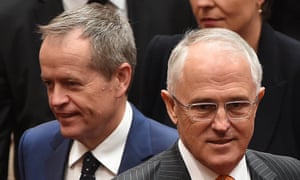Extract from The Guardian
Cutting
through the hyperbole about Malcolm Turnbull’s “risky roll of the dice”
and the predictable posturing about who can claim to be the underdog,
let’s focus on what we know about the looming election campaign. The
polls look fairly close but a lot can change in 74 days.
The swing will not be uniform. Nationwide polls hide big variations on the ground. In last year’s UK election, the national polls predicted the Conservatives and Labour would be neck-and-neck but seat variations and a highly targeted marginal seat campaign, run by the Australian Liberal party strategists Crosby Textor, helped take David Cameron to a decisive victory. Many of the marginal seats being defended by the major parties in Australia are in outer suburban or regional areas and strategists on both sides say regional variations are “very volatile”, largely because of a sense of uncertainty about the future of the economy and jobs.
Shorten is targeting these seats – often with lower than average household incomes and higher than average unemployment – with his message of “economic nationalism”, pledges to protect manufacturing jobs and maintain essential services by closing tax loopholes enjoyed by “the top end of town”. He is targeting Turnbull in not very subtle fashion as the representative of the aforementioned “top end”.
Labor sources say Turnbull’s talk about “agility” and “innovation” goes down like a lead balloon in these electorates. The Coalition is appealing to the same change-weary voters with the message that Turnbull is a better bet to deliver economic and political stability and Shorten is untested, uninspiring and a risk. They point to the fact that voters remain uncertain about Shorten and Labor.
The parties are already wheeling out these pitches. The deputy prime minister, Barnaby Joyce, said on Tuesday the choice was between “someone who has made a quid in their life, made a success of their life, or a nation run by Bill Shorten”. Shorten says the “contest is between Labor putting people first and a Liberal party looking after vested interests and the big banks”.
Momentum
“The big mo” is favouring Labor. The trends in the two-party preferred vote (Labor now level pegging or slightly ahead), satisfaction rating (Turnbull plummeting but still ahead, Bill Shorten rising) and preferred prime minister (Turnbull still ahead but his lead has been halved) are all favouring the ALP. And “events” – the great imponderables of campaigns – have also been helping Labor. The Panama papers and revelations about tax avoidance and minimisation have bolstered Labor’s policy that revenue can be raised from closing loopholes without adding to the tax burden of ordinary households. The division and leaks have been on the government side. The government is banking on the 3 May budget to change the policy momentum – it can probably only cross its collective fingers about the leaks.The swing
In real terms, the Coalition is still ahead. Labor needs a uniform swing of 4.3% and needs to win 21 seats to claim victory. Translating even the most favourable two-party preferred vote (51:49) to actual seats does not ensure a Labor win. The average of the current polls would still see a clear Coalition victory.Labor’s soft primary vote
Labor’s primary vote is somewhere between 33% and 36%, depending on the poll. Labor has never won with a primary vote that low. Even in 2010, when Julia Gillard negotiated her way into government in a hung parliament, the primary vote was 37.9%.The swing will not be uniform. Nationwide polls hide big variations on the ground. In last year’s UK election, the national polls predicted the Conservatives and Labour would be neck-and-neck but seat variations and a highly targeted marginal seat campaign, run by the Australian Liberal party strategists Crosby Textor, helped take David Cameron to a decisive victory. Many of the marginal seats being defended by the major parties in Australia are in outer suburban or regional areas and strategists on both sides say regional variations are “very volatile”, largely because of a sense of uncertainty about the future of the economy and jobs.
Shorten is targeting these seats – often with lower than average household incomes and higher than average unemployment – with his message of “economic nationalism”, pledges to protect manufacturing jobs and maintain essential services by closing tax loopholes enjoyed by “the top end of town”. He is targeting Turnbull in not very subtle fashion as the representative of the aforementioned “top end”.
Labor sources say Turnbull’s talk about “agility” and “innovation” goes down like a lead balloon in these electorates. The Coalition is appealing to the same change-weary voters with the message that Turnbull is a better bet to deliver economic and political stability and Shorten is untested, uninspiring and a risk. They point to the fact that voters remain uncertain about Shorten and Labor.
The parties are already wheeling out these pitches. The deputy prime minister, Barnaby Joyce, said on Tuesday the choice was between “someone who has made a quid in their life, made a success of their life, or a nation run by Bill Shorten”. Shorten says the “contest is between Labor putting people first and a Liberal party looking after vested interests and the big banks”.

No comments:
Post a Comment